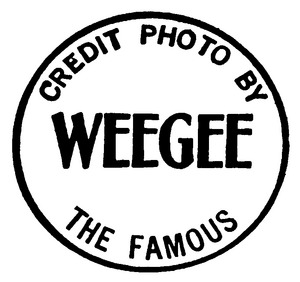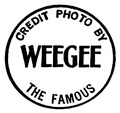Weegee facts for kids
Quick facts for kids
Weegee
|
|
|---|---|

Weegee in 1945
|
|
| Born |
Ascher (Usher) Fellig
June 12, 1899 Złoczów, Galicia, Austria-Hungary (now Zolochiv, Ukraine)
|
| Died | December 26, 1968 (aged 69) New York City, U.S.
|
| Other names | Arthur Fellig |
| Occupation | Photographer |
| Known for | Street photography of crime scenes or emergencies |
Arthur Fellig (born June 12, 1899 – died December 26, 1968), known by his special name Weegee, was a famous photographer. He was known for his clear black and white photos of everyday life in New York City.
Weegee worked as a newspaper photographer in New York during the 1930s and 1940s. He created his unique style by following the city's emergency teams. He took pictures of city life, often showing real scenes of events happening in the streets. Weegee also published photo books and worked on movies. He even made his own short films and helped famous directors like Stanley Kubrick.
Weegee was born Ascher Fellig in a place called Złoczów (now Zolochiv, Ukraine). His family moved to New York in 1909. When they arrived, his name was changed to Arthur. In Brooklyn, where they lived, he did many different jobs. He even took pictures of children on a pony!
In 1924, he got a job working in a darkroom for a news photo company. He left that job in 1935 to become a freelance photographer. This meant he worked for himself. Weegee once said that he didn't wait for someone to give him a job. Instead, he created his own job as a freelance photographer.
He would go to the Manhattan Police Headquarters and listen to their radio. When a big event happened, he would rush to the scene. His goal was to take pictures and sell them to newspapers. He worked mostly at night and tried to get to the scene before the police. His photos were often published in popular newspapers like the Daily News and magazines like Life.
In 1957, Weegee became sick with diabetes. He moved in with Wilma Wilcox, a social worker who helped him and later took care of his work. He traveled a lot in Europe until 1964. He worked for a London newspaper and on many photo, film, and book projects. Weegee passed away in New York on December 26, 1968, when he was 69 years old.
Contents
Why was he called Weegee?
The exact reason for Fellig's nickname is not fully known. One of his first jobs was in a photo lab. There, he was called "squeegee boy" because he used a tool called a squeegee to wipe down photos.
Later, when he worked for a news photo company, he was very good at developing photos quickly. He could even do it on the go, like in a subway car! This earned him the name "Mr. Squeegee."
Some people think he was called "Weegee" (which sounds like "Ouija") because he seemed to know where to go. He would arrive at crime scenes or emergencies so quickly, it was almost like he had a magical Ouija board telling him where to go.
How did Weegee take his photos?
Weegee used simple camera equipment for most of his famous photos. He used a 4x5 Speed Graphic camera. He set it to take pictures at a certain light level and speed, using flashbulbs. He taught himself how to take photos and did not have any formal training.
Many people used to say that Weegee developed his photos in a darkroom he built in the trunk of his car. However, this is not true. He did not do that.
Weegee knew what kind of photos would sell best to newspapers. He said that if a famous person had a fight, it would be big news. But if it was just a regular fight, nobody would care as much.
A common saying in photography is "f/8 and be there." This means to be at the right place at the right time with your camera ready. Some people say Weegee said this, but it's probably not true. His usual camera settings were different. A book about him from 1953 said he often shot photos from 6 feet away at a setting called f/22, or 10 feet away at f/16. These settings helped him get clear photos with a lot in focus. He also carried a flashlight to change his camera settings in the dark.
Some of Weegee's photos, like the one called The Critic (1943), were later found to be staged. This means he set up the scene instead of just capturing it as it happened.
Weegee's busy years (1930s-1940s)
In 1938, Weegee became the only freelance newspaper photographer in New York with a special permit. This permit allowed him to have a portable police radio. He worked mostly at night, listening to the radio. This helped him often arrive at a scene even before the police!
In 1943, five of his photographs were bought by the Museum of Modern Art (MoMA). His work was shown in their "Action Photography" exhibition. He also gave talks at the New School for Social Research. Soon, magazines like Life and Vogue started asking him to take pictures for them.
Naked City (1945) was his first book of photographs. A film producer named Mark Hellinger bought the rights to the title from Weegee. In 1948, Weegee's style inspired Hellinger's film also called The Naked City. This movie was about a murder investigation in New York. The title was later used for a TV show about police and even a band.
Weegee also appeared in the 1949 film The Set-Up. He played a small role, ringing the bell at a boxing match.
Weegee's later years (1950s-1960s)
Weegee started making his own 16mm films in 1941. He also worked in Hollywood from 1946 to the early 1960s. He was an actor and a helper on movie sets. He helped with special effects for Stanley Kubrick's 1964 film Dr. Strangelove or: How I Learned to Stop Worrying and Love the Bomb. Weegee's way of speaking even influenced how the main character in the movie talked!
In the 1950s and 1960s, Weegee tried new things with his photography. He took wide, panoramic photos and used special lenses to make distorted pictures. He even took a famous photo of Marilyn Monroe where her face looked strange but you could still tell it was her. For the 1950 movie The Yellow Cab Man, Weegee created a scene where car traffic looked wildly twisted. He also traveled a lot in Europe in the 1960s.
In 1962, Weegee starred as himself in a film called The 'Imp'probable Mr. Wee Gee. It was meant to be a movie about his life.
Weegee's lasting impact
Weegee is often compared to Brassaï, another photographer who took pictures of Paris street scenes at night. Weegee's interest in circus performers and unique street people later inspired other photographers, like Diane Arbus.
In 1980, Weegee's friend Wilma Wilcox and others created a special collection of his photos. These prints were made from Weegee's original negatives. Wilma Wilcox later gave all of Weegee's work – 16,000 photos and 7,000 negatives – to the International Center of Photography in New York. This huge gift led to many exhibitions and books about his work.
In 2009, an exhibition called Elevator to the Gallows showed Weegee's night photos. In 2012, another Weegee exhibition called Murder Is My Business opened. Also in 2012, an exhibition called Weegee: The Naked City opened in Moscow. Weegee's own story, called Weegee by Weegee, was republished in 2013.
From April 2013 to July 2014, a museum in Austria showed an exhibition called Weegee. How to photograph a corpse. It featured many of Weegee's photos, including old prints and newspapers from when the photos were first taken.
Images for kids
Where to see his work
You can find Weegee's photographs in many public collections, including:
- Art Institute of Chicago, Chicago, IL
- Museum of Modern Art, New York
- The Jewish Museum]
- Rijksmuseum Amsterdam
- International Center of Photography
See also
 In Spanish: Weegee para niños
In Spanish: Weegee para niños
- The Public Eye – A movie that tells a made-up story inspired by Weegee's life.
- Ƒ/8 and be there




